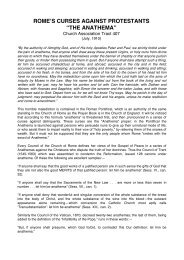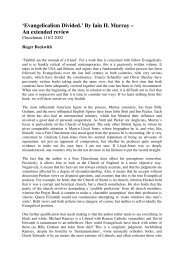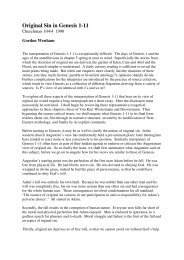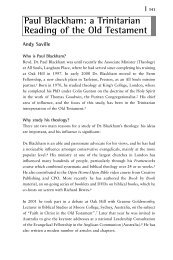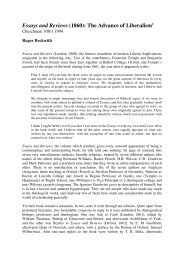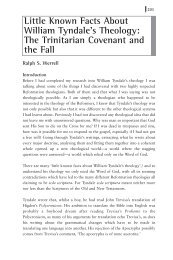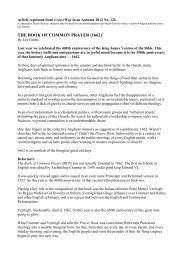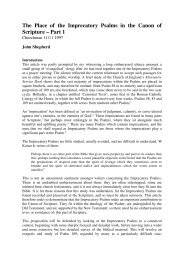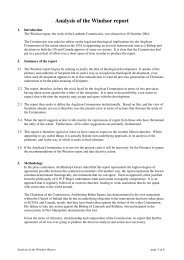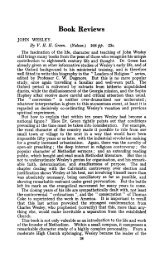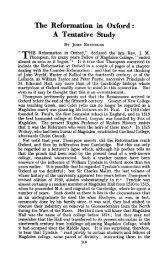The Holy Spirit in the Teaching of Charles Simeon - Church Society
The Holy Spirit in the Teaching of Charles Simeon - Church Society
The Holy Spirit in the Teaching of Charles Simeon - Church Society
You also want an ePaper? Increase the reach of your titles
YUMPU automatically turns print PDFs into web optimized ePapers that Google loves.
he is subord<strong>in</strong>ate both to <strong>the</strong> Fa<strong>the</strong>r and <strong>the</strong> Son.” <strong>The</strong> first respect <strong>in</strong> which he is subord<strong>in</strong>ate<br />
is “<strong>in</strong> <strong>the</strong> order <strong>of</strong> subsistence, as <strong>the</strong> Fa<strong>the</strong>r is not <strong>of</strong> <strong>the</strong> Son, but <strong>the</strong> Son <strong>of</strong> <strong>the</strong> Fa<strong>the</strong>r, so<br />
nei<strong>the</strong>r <strong>the</strong> Fa<strong>the</strong>r nor <strong>the</strong> Son proceeds from <strong>the</strong> <strong>Spirit</strong>, but <strong>the</strong> <strong>Spirit</strong> from <strong>the</strong>m, <strong>in</strong>asmuch as<br />
he proceeds from <strong>the</strong> Fa<strong>the</strong>r and is sent by <strong>the</strong> Son”. <strong>The</strong> second aspect <strong>of</strong> His subord<strong>in</strong>ation<br />
is “<strong>in</strong> <strong>the</strong> order <strong>of</strong> operation”, that is, <strong>in</strong> His <strong>of</strong>fice <strong>in</strong> <strong>the</strong> economy <strong>of</strong> redemption. Canon<br />
Fison has diagnosed <strong>the</strong> <strong>Spirit</strong>’s subord<strong>in</strong>ation as result<strong>in</strong>g from His “<strong>in</strong>curable tendency to<br />
self-effacement”, 5 and <strong>Simeon</strong> notes <strong>the</strong> four ages <strong>of</strong> this trait <strong>in</strong> His div<strong>in</strong>e character.<br />
“Before <strong>the</strong> time <strong>of</strong> Christ’s <strong>in</strong>carnation . . . he <strong>in</strong>spired <strong>the</strong> prophets to foretell <strong>the</strong> th<strong>in</strong>gs <strong>in</strong><br />
relation to His suffer<strong>in</strong>gs and glory. Dur<strong>in</strong>g <strong>the</strong> days <strong>of</strong> our Lord’s m<strong>in</strong>istry on earth . . . it was<br />
by <strong>the</strong> <strong>Spirit</strong> that Christ cast out devils, and performed his o<strong>the</strong>r miracles. . . . After He had<br />
ascended <strong>in</strong>to heaven it was <strong>the</strong>n that <strong>the</strong> <strong>Spirit</strong> began fully to execute <strong>the</strong> <strong>of</strong>fice assigned to<br />
him, and to ‘glorify Christ’ before an ungodly and unbeliev<strong>in</strong>g world. To this very hour does<br />
<strong>the</strong> <strong>Spirit</strong> bear <strong>the</strong> same part ‘conv<strong>in</strong>c<strong>in</strong>g <strong>the</strong> world <strong>of</strong> s<strong>in</strong>, <strong>of</strong> righteousness and <strong>of</strong> judgement’<br />
<strong>in</strong> order to magnify Christ and to enlarge His k<strong>in</strong>gdom” (ibid).<br />
<strong>The</strong>re is, <strong>the</strong>n, an orthodox subord<strong>in</strong>ation <strong>of</strong> <strong>the</strong> <strong>Spirit</strong> to <strong>the</strong> Fa<strong>the</strong>r and <strong>the</strong> Son. “But <strong>the</strong><br />
<strong>in</strong>feriority is not personal, but <strong>of</strong>ficial; not as <strong>the</strong> Sacred Three subsist <strong>in</strong> <strong>the</strong>mselves, but as<br />
<strong>the</strong>y susta<strong>in</strong> and execute <strong>the</strong>ir respective <strong>of</strong>fices <strong>in</strong> <strong>the</strong> economy <strong>of</strong> redemption” (Sermon<br />
1863). Such is <strong>Simeon</strong>’s statement <strong>of</strong> <strong>the</strong> person <strong>of</strong> <strong>the</strong> <strong>Holy</strong> <strong>Spirit</strong>. It is deficient <strong>in</strong> that it has<br />
no deep <strong>in</strong>sight <strong>in</strong>to <strong>the</strong> unity <strong>in</strong> Tr<strong>in</strong>ity beyond its mere statement as a fact. It has, however,<br />
what <strong>the</strong> generality <strong>of</strong> Christians lack: that is, a fully scriptural appreciation <strong>of</strong> <strong>the</strong> <strong>Spirit</strong>’s<br />
person deduced from His work <strong>in</strong> redemption. <strong>The</strong> result is a sound orthodoxy which will<br />
never allow Him to be relegated to “a poor third” and consequently thought <strong>of</strong>, however<br />
unwitt<strong>in</strong>gly, as less than personal.<br />
II<br />
Whilst we must depend most fully on <strong>the</strong> observed work <strong>of</strong> <strong>the</strong> <strong>Spirit</strong> <strong>in</strong> redemption and post-<br />
Calvary experience for our knowledge <strong>of</strong> Him, <strong>the</strong> fact rema<strong>in</strong>s that <strong>the</strong> relationship between<br />
man and <strong>the</strong> <strong>Spirit</strong> began, not at Pentecost, but at <strong>the</strong> moment <strong>of</strong> creation. <strong>Simeon</strong> rem<strong>in</strong>ds us,<br />
as we come to consider <strong>the</strong> work <strong>of</strong> <strong>the</strong> <strong>Spirit</strong>, that “None but he who moved upon <strong>the</strong> chaos,<br />
and formed it <strong>in</strong>to order and beauty can new create <strong>the</strong> soul” (Sermon 2192). St. John began<br />
his Gospel with <strong>the</strong> formula <strong>of</strong> Genesis i. 1 because <strong>the</strong> re-creation <strong>of</strong> man made possible<br />
through Christ and made effective through <strong>the</strong> <strong>Holy</strong> <strong>Spirit</strong> is <strong>the</strong> new creation directly parallel<br />
with <strong>the</strong> orig<strong>in</strong>al creation. Fr. Lionel Thornton has spoken <strong>of</strong> “<strong>the</strong> essential repetition <strong>in</strong>herent<br />
<strong>in</strong> spiritual truth”, and this must be <strong>the</strong> basis for all legitimate typology which seeks, not to<br />
distort <strong>the</strong> old to verify <strong>the</strong> new, but to see <strong>the</strong> unchang<strong>in</strong>g pattern <strong>of</strong> <strong>the</strong> div<strong>in</strong>e activity<br />
runn<strong>in</strong>g through both. <strong>The</strong> Λóγος [Word] and <strong>the</strong> Πνευµα του Θεου [<strong>Spirit</strong> <strong>of</strong> God] are seen<br />
at work <strong>in</strong> both <strong>of</strong> <strong>the</strong> covenants <strong>of</strong> God. In Gen. i <strong>the</strong> ‘ruach Jahweh’ [God’s <strong>Spirit</strong>/breath] is<br />
jo<strong>in</strong>ed with <strong>the</strong> ‘dabar Jahweh’ [God’s Word] as <strong>the</strong> creative ενεργεια [work<strong>in</strong>g]. <strong>The</strong> New<br />
covenant is new, because <strong>in</strong> it a new creation comes <strong>in</strong>to be<strong>in</strong>g by a second concerted act <strong>of</strong><br />
<strong>the</strong> Word and <strong>the</strong> <strong>Spirit</strong>. This is stated by <strong>Simeon</strong> with a deceptive naïveté when he says,<br />
“Meth<strong>in</strong>ks <strong>the</strong>re is some analogy between <strong>the</strong> first creation <strong>of</strong> all th<strong>in</strong>gs and this new creation<br />
which takes place <strong>in</strong> <strong>the</strong> soul <strong>of</strong> man” (Sermon 1117). It is, however, <strong>the</strong> rul<strong>in</strong>g thought <strong>in</strong> all<br />
that he wrote and believed concern<strong>in</strong>g “<strong>the</strong> Lord and Giver <strong>of</strong> Life”.<br />
Dur<strong>in</strong>g <strong>the</strong> <strong>in</strong>terim period between <strong>the</strong> Fall and <strong>the</strong> Atonement <strong>the</strong> work <strong>of</strong> <strong>the</strong> <strong>Spirit</strong> was to<br />
glorify Christ as <strong>the</strong> promised Saviour. “It was by <strong>the</strong> <strong>Holy</strong> Ghost that Christ spake <strong>in</strong> <strong>the</strong><br />
m<strong>in</strong>istry <strong>of</strong> Noah to <strong>the</strong> antedeluvian world (1 Pet. iii. 18-20), and <strong>in</strong>structed all his people <strong>in</strong>



